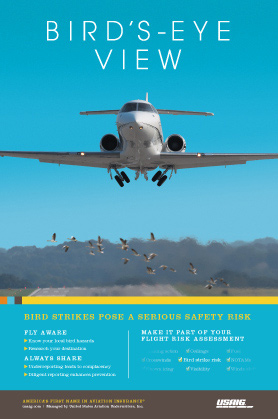Making It Safe to Talk About Safety
It’s time to talk safety. Channels that offer actual-user communication are a good place to start. Face-to-face events, online forums and social media can help expand the conversation. People seek insight from other people in the know. There’s no better source than word of mouth from a trusted source.
The Wichita Aero Club’s August presentation by National Transportation Safety Board (NTSB) Vice Chairman Robert Sumwalt offers an excellent example of information from a proven authority. Sumwalt’s personally logged 14,000+ flight hours – with more than half of those in aircraft built in Wichita. You might say, he had the crowd at hello. He had attendees even more when he added, “I have a great affinity for the products that come out of this wonderful town.”

As a young man smitten with the skies, Sumwalt earned his pilot’s license before graduating high school. He read NTSB accident reports to make himself a better pilot. “Good people can get into bad situations,” he said. Seeing the five signatures on those reports created a goal to one day serve on the NTSB himself.
Sumwalt made his first trip to the Air Capital of the World – which he also called the Mecca of Aviation – to train with FlightSafety International in January 1981. He wrapped up his training on a Thursday and the following Monday received a job offer with a commercial airlines. The then 32-year-old stepped into the cockpit of a Boeing 727, beginning a 24-year career as an airline pilot. Always drawn to the lessons learned when things go wrong, Sumwalt has served on industry accident-investigation boards and human factors committees; helped found programs guiding critical response in traumatic situations; authored a book and numerous accident-based articles; and consulted NASA on aviation safety. The guy knows his stuff.
Working to Make Bad News Better
Sumwalt joined the NTSB in 2006 and has served as chairman of the board of inquiry for planes small and large. He oversaw the 2009 bird strike and emergency landing that the world came to know as the Miracle on the Hudson. He lauds the NTSB team for its independence, credibility and all-out dedication. Its advocacy – laid out as a Most Wanted List – defines 10 top action areas. Two are for aviation: airport service operations and general aviation safety.

“I get the worst text messages, and I’m not talking about the ones from Anthony Weiner,” Sumwalt said to the crowd’s laughter. He pulled up a stream of messages you and I would never want to see on our smartphones. Collisions. Runway excursions. Fires. Of the NTSB, he said, “We’re here for one reason – safety.”
With the highly successful EAA AirVenture at Oshkosh, Wisconsin just ending, Sumwalt didn’t shy away from addressing the issue of general aviation safety. The professionally flown, turbo-powered aircraft segment enjoys a safety record as good as or better than its commercial counterpart. But GA also includes experimental, amateur-built (EAB) aircraft. And those numbers tell a different story. While these 33,000 planes make up only 10 percent of the GA fleet, they account for 15 percent of the accidents and 21 percent of fatal accidents. “I would never fly anything I built,” Sumwalt said.
The NTSB’s yearlong study in 2011 found most EAB accidents to be due to engine malfunctions and pilots whose maneuvers exceed their capabilities. Among the study’s recommendations: more pilot training and heightened requirements for initial aircraft airworthiness certification.
A Look at the Numbers
The NTSB’s mission: prevent accidents, reduce injuries, save lives. A look at recent numbers inspires hope – showing fewer total accidents and fewer fatalities. But ever willing to provide clarity, Sumwalt pointed out that those reductions can be traced to a reduction in flying itself. Once you look at it from a per-100,000-flight-hour basis, the chart flattens out. You see no significant improvement. With GA’s accident rate 40 times greater than commercial, scheduled carriers, Sumwalt added, the scenario’s “ripe for improvement.”
At Greteman Group, we pledge to do our part as communicators. Talking about the issues and shining light on efforts that promise to make our skies safer.
NTSB Member Robert Sumwalt will speak at this fall’s Bombardier Safety Standdown USA, September 30 – Oct. 3, in Wichita, Kansas. You can register at: http://www.safetystanddown.com/aviation-safety-seminars/united-states-2013

Poster Strikes a Note for Safety
Pilots know birds can cause serious damage to their aircraft. But they may think nothing can be done other than to remain vigilant. USAIG is out to change that perception. This poster drives home the importance of reporting every strike and near-strike. That’s the only way to build a database on bird strike patterns. Even as that database grows, there’s already a significant amount of airport-specific information available. The poster urges pilots to take the precautionary step of checking out bird strike patterns at their home airport and at any intended destinations. USAIG may stand for United States Aircraft Insurance Group, but the nation’s oldest aviation-focused underwriter is as much in the safety business as it is insurance. This poster is the first in a series. They’re free for the asking from USAIG.
* Pictured at the top of the story, Ashley Bowen Cook was doubly impressed when she went up to congratulate Robert Sumwalt on a job well done following his August 7 Wichita Aero Club presentation – and he called her by name. He remembered her from a meeting at Bombardier Safety Standdown two years ago. His memory for details extends to more than accident reporting. Photography: Dan Moore
**This article originally appeared in the Aug 29 issue of BlueSky Business Aviation News.